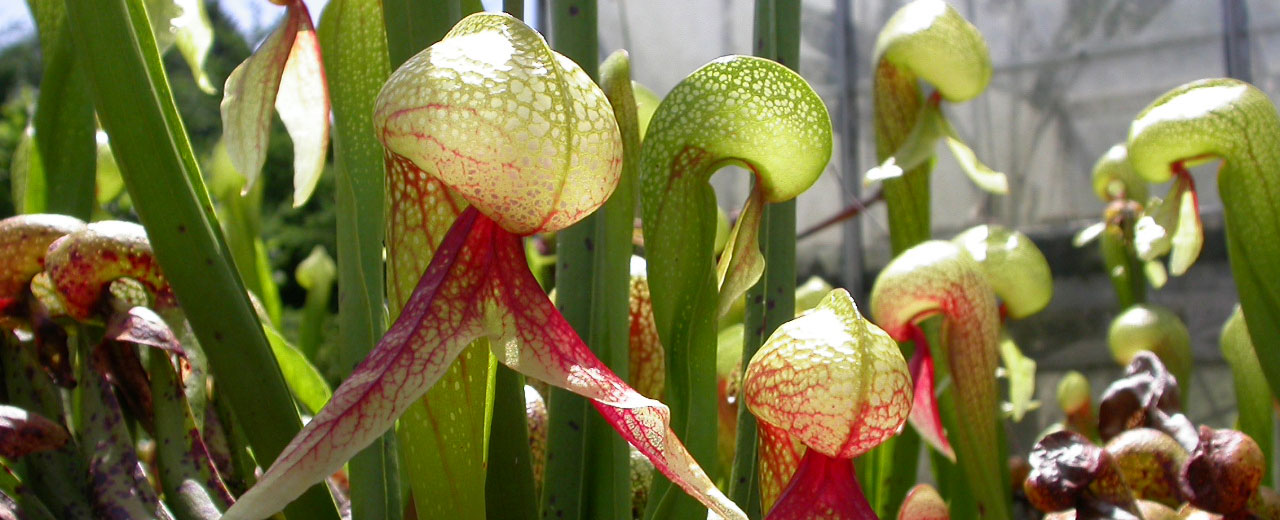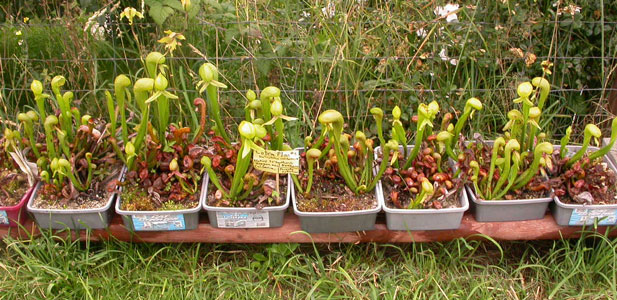Darlingtonia californica Care
Get the straight facts from guys who grow and propagate thousands of carnivorous plants every year.

The cobra plant, Darlingtonia californica, is an awesome plant in person, and the second most requested plant from our customers after the Venus flytrap. When fully grown, its pitchers can tower 3 feet tall with heads the size of fists! But we'll be straightforward about it: Darlingtonia are finicky and one of the most challenging of all carnivorous plants. It prefers moderate summers, cool nights, well-drained soil, fresh water, and chilly winters. The cobra plant is not very forgiving of mistakes, so everything has to be just right.
If you’ve successfully grown Sarracenia and other outdoor carnivorous plants in the past, you will enjoy the challenge of Darlingtonia. If you’re new to growing carnivorous plants, gain some experience with other plants first. Get a handle on the basic elements of cultivation by reading The Ultimate Carnivorous Plant Guide for Beginners to learn more about growing some of the easier and more common plants in cultivation.
Range
Darlingtonia is native to remote mountain streams in Southern Oregon and Northern California. A few smaller patches grow in lowland streams along the Oregon coast, but the majority reside in the mountains. Those that are native to the mountains tend to be much more resilient to extreme temperature changes than those from the mild Oregon coast.
Where to Grow
Darlingtonia grow best outdoors as a container plant on a sunny deck or patio. You may also grow it in a pond or fountain with flowing water, but keep the crown of the plant from being submerged. Because of its specific soil requirements, avoid planting it in the ground.
Sunlight
Darlingtonia requires partial to full sun (4 or more hours of direct sunlight) for vigorous growth during the growing season. Although Darlingtonia can grow in some shade, avoid full shade. When in doubt, give more sunlight.
Heat Tolerance
Darlingtonia can withstand extreme heat for short periods of time. In its native habitat, Darlingtonia will experience temperatures of 104°F during the summer. However, if daytime temperatures rise above 90°F, nighttime temperatures need to drop significantly, such as the low 60s or less. Cool nights are essential for the overall health of this plant.

Water
Your watering method will be the most important factor in growing
Darlingtonia. Soil aeration is vital for it. We highly recommend watering your Darlingtonia daily and allowing it to drain through completely rather than setting it in standing water as you would for Sarracenia. Daily watering mimics what Darlingtonia experience in the wild, where a constant, slow stream of cool water washes over its roots, cooling the plant and rinsing the soil of nutrients or organic chemical buildup.
On hot summer days, water your Darlingtonia in the morning and evening. If you have trouble remembering to water your plant daily, consider using a faucet timer with a drip system. If daily watering is not feasible, then use the tray method and keep your plant in small amounts of water, no more than 1/2 inch.
Darlingtonia is tolerant of relatively hard water, up to 150 ppm of dissolved minerals, so using pure water (under 50 ppm of dissolved minerals) isn't at all necessary as long as you're allowing the water to drain through. If you choose to set your plant in standing water, you should use pure water.
Soil
Over the years, we've experimented with a variety of soil mixes. In the end, we found that a very simple mix of one part peat moss and two parts perlite was as successful as other mixes we used. You can top dress the medium with live sphagnum moss to prevent splash erosion with top watering. Change the soil annually to maintain optimal root health.
Pots
The ideal type of pot for a
Darlingtonia is short and wide. Darlingtonia have short roots, so the container doesn’t have to be tall. However, because they self-propagate via long underground stolons, the pot needs to be wide. Because of their cold winter dormancy requirements, ceramic pottery, especially unglazed pottery, may be unfeasible as it tends to crack during freezes.
In our experiments, we discovered that plastic cat litter pans worked very well. They're wide containers than they are deep, with enough depth for Darlingtonia roots and enough width for the plant to comfortably spread. We used brand new pans from a local discount store. Along the sides of the pan, we punched small 1/4 inch holes about ½ inch from the bottom for drainage. Technically there will be sitting water ½ inch deep at the bottom of the pan, but as the surface area is ample enough and the soil relatively shallow, water will evaporate much faster. For a while, we grew the majority of our mother plants in these pans. If plastic cat litter pans are too unsightly, consider using wide plastic garden bowls.

Winter Care
Your plant will stop growing in early fall, and some pitchers will turn brown. These are signs that your plant will soon be dormant, a similar process when a rose bush goes dormant and drops its leaves in fall. While dormant, your Darlingtonia can withstand episodes of overnight frosts down to 20°F. If daytime temperatures are projected to rise above freezing, you don't need to protect it from these overnight frosts. However, protection is required during prolonged freezes to prevent dehydration or freeze drying, regardless of USDA zone. Covering your plant with a tarp or black plastic sheet will be sufficient if the freeze is expected to last for a week or less, which is typical for USDA zones 7 and 8. Otherwise, mulch may be required if you live in a region where freezing temperature is a way of life, such as in USDA zones 6 and colder.
Need more information about winter care? Watch the
Volume 1 playlist
and monthly videos.
Our digital download,
The Ultimate Carnivorous Plant Guide for Beginners,
is also a fantastic resource if you are new to growing plants. We share how various elements – sunlight, water, soil, and humidity – affect plant growth and what to pay attention to during winter dormancy. Visit the website to access these resources.

Supply is very limited.
Inventory changes seasonally.
